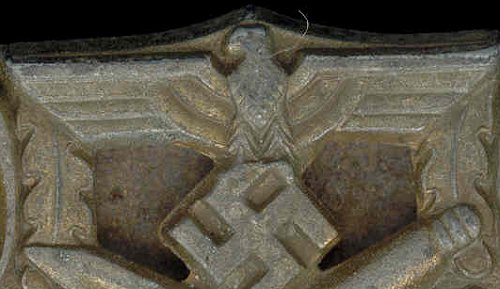
by Jacques Calero and Sebastián J. Bianchi
The Close Combat Bar was instituted on November 25, 1942, by Adolf Hitler, in order to recognize the courage of the German soldier in hand-to-hand combat. This award was completely independent of the Infantry Combat Badge. The badge designed by Wilhelm Ernst Peekhaus of Berlin (his name preceded by FEC can be found on the reverse of some examples), and was instituted in three classes, bronze, silver, and gold.


Manufacturing and Technical information
The badge is die cast and generally manufactured in zinc, though examples in tombac or aluminum are also found.. It is slightly convex, with the center piece consisting of the national emblem surmounting a crossed bayonet and hand grenade. This piece is cut out and backed with a flat square of blackened steel (magnetic), crimped in place on the reverse.
The pin is always broad in the center and tapering at the end. The bar varies in length from between 95 to 97.5mm, and in height from between 25 to 27mm (according to the Juncker, JFS and F&BL types).
Known makers are :
- Juncker of Berlin (particularity, the back plate is not magnetic)
- Gebrüder Wegerhoff of Lüdenscheid (GWL)
- Josef Feix & Sohn of Gablonz (JFS)
- Funcke & Brunninghaus of Lüdenscheid (F&BL)
- Friedrich Linden of Lüdenscheid (FLL)
- Rudolf Souval of Wien (RS)
- ArbeitGemeinschaft Metal und Kunstoff of Gablonz (AGMuK)
- Hymen & Co of Lüdenscheid (H&CL L/53)
- No mark
Presentation, Wear and Documents
Presentation of the badge was made by the company, Battalion or Regimental Commander (or equivalent). On March 26, 1944, Adolf Hitler reserved the right to personally present the close combat bar in gold as "the highest infantry decoration". On August 30, 1944, the gold class recipients were automatically presented the German cross in gold and were permitted to spend 21 days at home.
The Close Combat Badge decoration was to be worn 1 centimeter above the ribbon bar or mounted group. When more than one grade was presented to the same individual, only the highest grade was to be worn (though the recipient kept all grades in his possession).
An award document was given to the soldier (different types exist, it depending on the unit), and there was an entry in his Soldbuch attended with a detailed list of his combat days (unit, date, location).
The close combat bar was presented in a cardboard box or in celluloid .
Below is Hpt. Erhard LISS, 5./Sturm.Rgt.195 Ritterkreuz on April 30, 1945. He wears among other decorations the Silver Close Combat Bar . (Coll.Calero)

Award Criteria
The badge was presented based on the number of combat days as follows,
- Bronze class for 15 combat days
- Silver class for 30 combat days
- Gold class for 50 combat days
Criteria for a combat day was as follows,
All combat days in which the soldier had the opportunity to be close enough to "see the white of the enemy's eyes", use close combat weapons to assault the enemy man-to-man and be victorious.
Days in which the soldier was part of a mayor attack or assault, reconnaissance attack, defense of a position, or single messenger run.
These actions could take place in the front line or in the rear (against Partisans).
The initial combat days were established taking in count the uninterrupted time of engagement on the Eastern front since June 22 of 1941, or in Africa since March 26 of 1943 :
15 months = 15 combat days
12 months = 10 combat days
8 months = 5 combat days
This decoration was also awarded posthumously, in which case both decoration and certificate were sent to the next of kin. The Division commander was also able authorize the award to a wounded soldier who, because of permanent injury, would no longer have the opportunity to complete the minimum days, provided he completed the following,
Bronze Class - 10 days minimum
Silver Class - 20 days minimum
Gold Class - 40 days minimum
The Close Combat Bar was also awarded to members of the Luftwaffe, though it would later replaced by the Luftwaffe Close Combat Bar (Few is known about this badge, and no picture exist of its wear).
This article be not complete without a mention of the gold bar presentation. According to Manfred Dörr's book on this subject, about 600 gold bar were awarded. The bar was in every respect the same design than the other classes, but gilded - a special fire gilded badge does exist. This badge was presented during an official ceremony, directly by Hitler then by Himmler and Guderian.





Ivan Bombardieri Collection
![]()
© Copyright Wehrmacht-Awards.com LLC |